
Beijing, China - The Forbidden City cover page. |
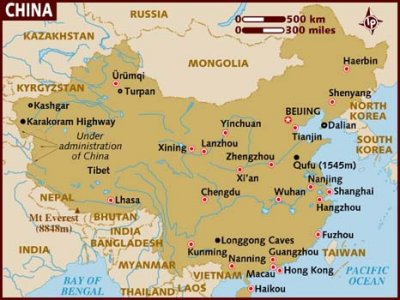
Map of China with the star indicating Beijing. |
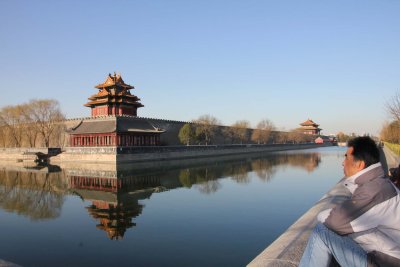
Moat surrounding the Forbidden City with a Chinese man contemplating the Northwest Tower. |

View of the Northwest Tower. |
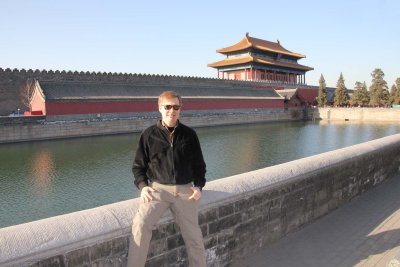
Me posing outside of the Forbidden City. |
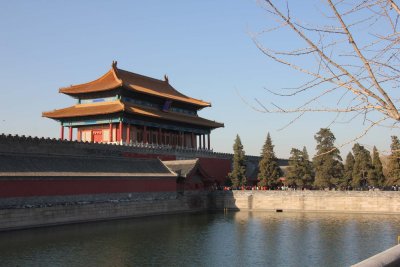
View of Shenwumen, the Gate of Divine Prowess, the northern gate of the Forbidden City. |
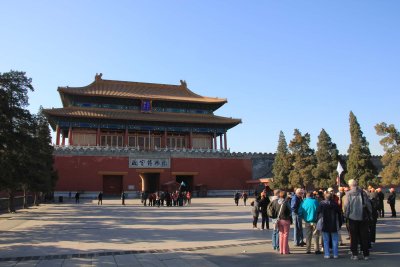
Both in Ming and Qing Dynasties, the empresses would come and go through this gate for official ceremonies |
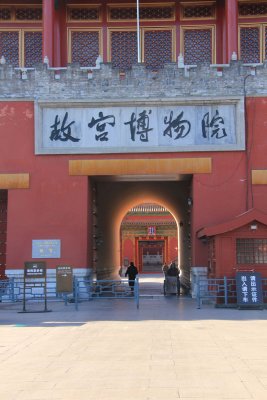
Close-up of the Gate of Divine Prowess. |
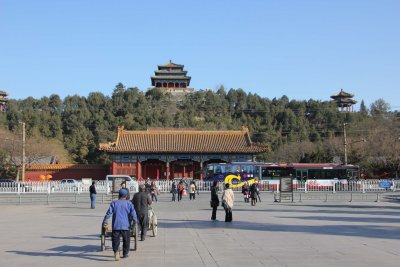
The outer court behind the Gate of Divine Prowess. |

This two-storey building is just situated in the south-north axis of the City, where the Emperors' edicts were announced. |
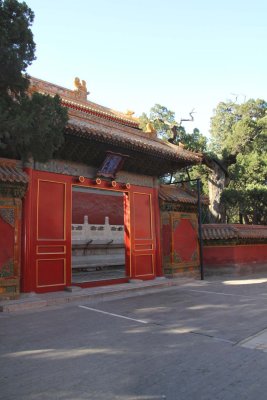
Another smaller gate near the Imperial Garden. |
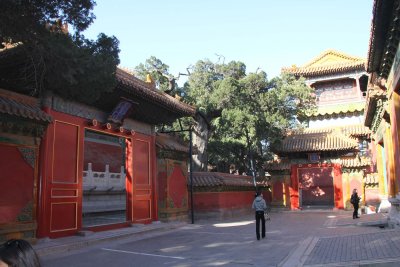
This inner courtyard was also within the gate. |
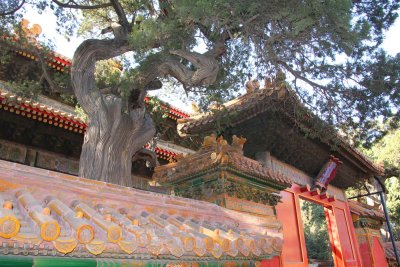
Rooftop details and a sinuous cypress tree off of the courtyard. |
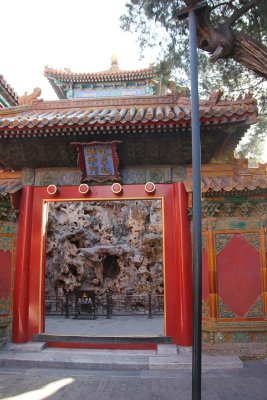
Gate of Prolonged Harmony, Imperial Gate. Through this gate are the Perilous Hills. |
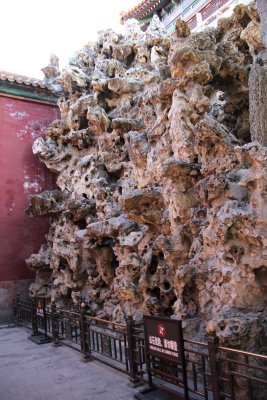
Another Perilous Hills view. |
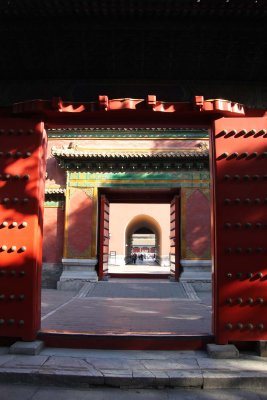
Doors heading into the inner sections of the Forbidden City. |
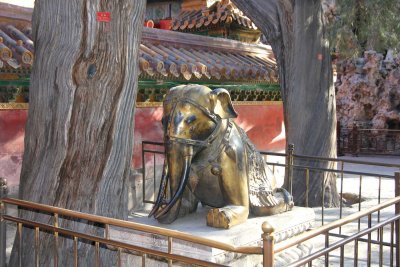
A bronze elephant and cypress trees within the Royal Garden. |

Internal wall with decorated with dragons. |
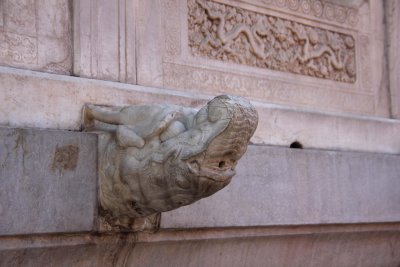
Dragon heads are used as water spouts. In Chinese mythology, Paxia, the sixth of the dragon's nine sons, loved water. |
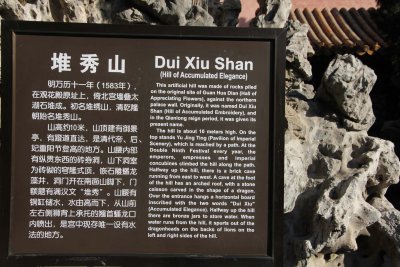
Sign for Diu Xiu Shan, the Hill of Accumulated Elegance. |

The hill is about 10 meters high. On top stands Yu Jing Ting (the Pavilion of Imperial Scenery), which is accessible by a path. |
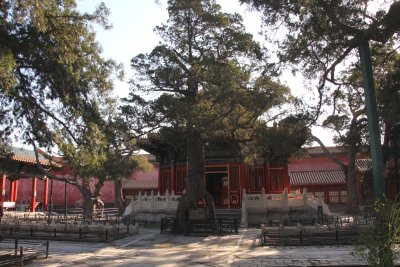
Courtyard in the Imperial Garden is where members of the imperial household came to relax. |
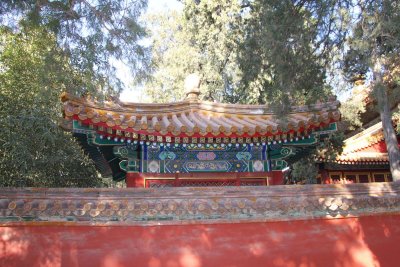
Exquisite architectural details in the garden. |
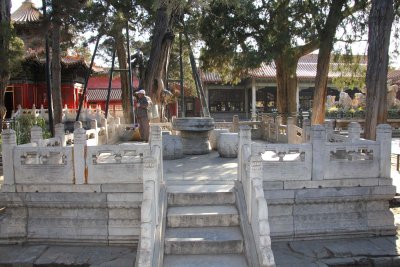
A table and seats on this marble stand. |
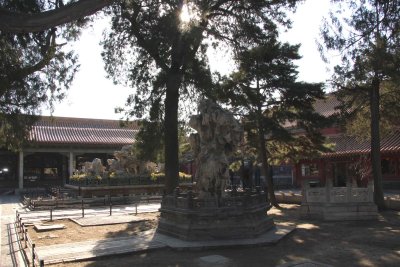
An ornamental rock formation in the Imperial Garden. |
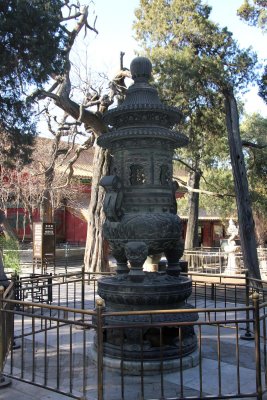
A gilded bronze incense burner in Imperial Garden, Forbidden City. |
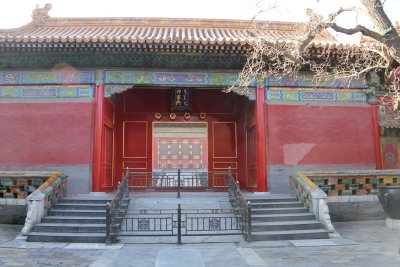
Outer courtyard building with dual steps. |

Branch interlocked cypresses symbolize love. Puyi and Wanrong, the last emperor and empress, had a wedding picture taken here. |

A royal water vat with decorative handles. |
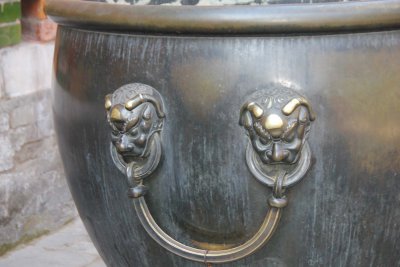
Close-up of the handles. The vats were guilded in the Qing Dynasty. |
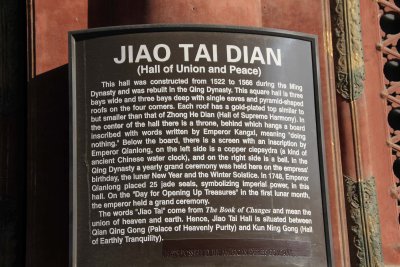
The Hall of Union and Peace, built during the Jiajing reign (1522 to 1566) - Ming Dynasty. |
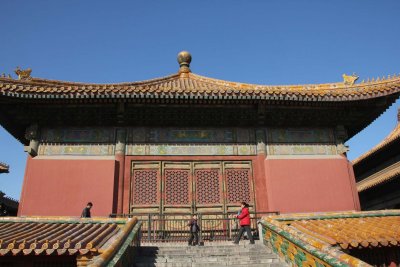
Frontal view of the hall. |
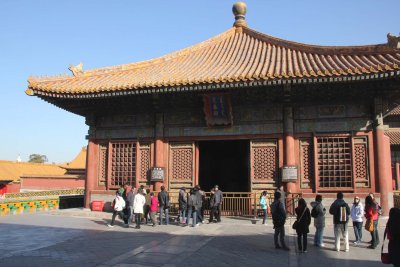
Many tourists were there that day. |
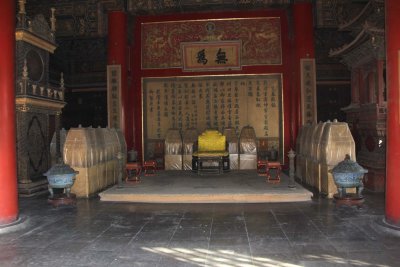
Interior of the Hall of Union and Peace. |

The empress used the Hall of Union and Peace for receptions. |

The hall symbolizes the union between heaven and earth, between Yin and Yang, male and female, and the emperor and empress. |
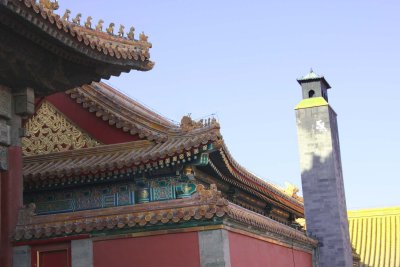
Architectural details of the Hall of Union and Peace. |

Directly east from the Hall of Union and Peace, the Jinghe Gate now serves as display space for the Palace Museum. |
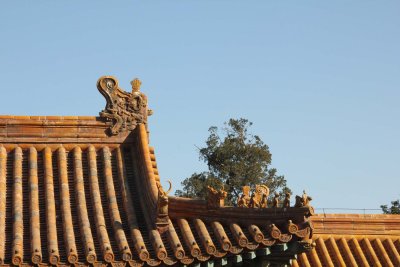
Beast figures are widespread on the buildings in the Forbidden City. The more beasts, the more important the building. |

Courtyard near the the Palace of Earthly Tranquility. |
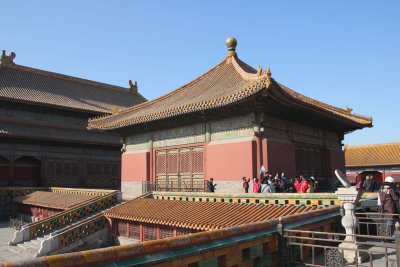
Note the sundial off of the courtyard. |
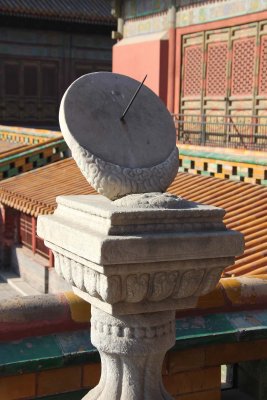
Sundial, with its intricate detailing, is located outside the Emporer's wife's quarters, the Palace of Earthly Tranquility. |

Interior view of the Empress' quarters in the Palace of Earthly Tranquility. |
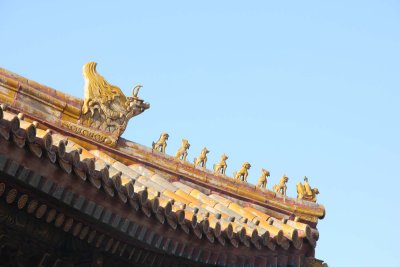
More beast figures on the roof. On the far left is a dragon and on the right an immortal rides a phoenix. |
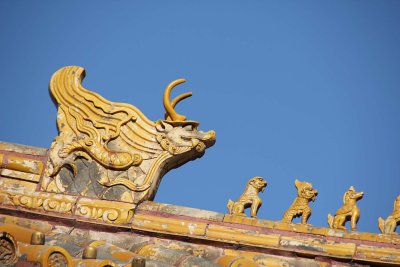
Close-up of the dragon on the left. |

Some more rooftop beasts. This is an important building because there are so many. |
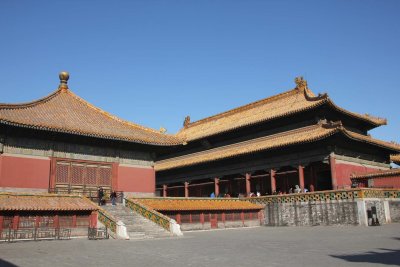
Yellow is a royal color, thus the color of the roof tiles. The red color of the walls symbolize happiness and auspiciousness. |
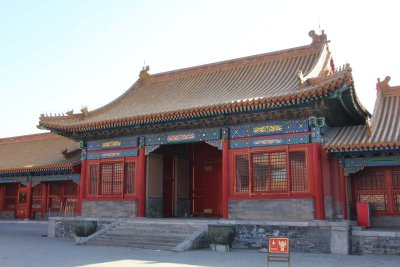
View of the Jinghe Gate. It serves as display space for the Palace Museum. There is another similar gate on the west side. |

Palace of Heavenly Purity is the largest construction in the Inner Court of the Forbidden City. |
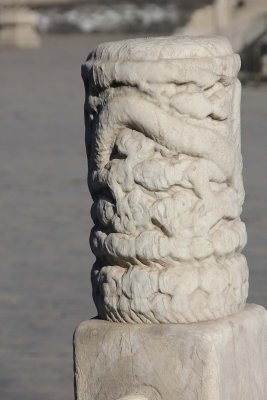
Stone carving near the Palace of Heavenly Purity. In the Ming and Qing Dynasties, it once was the residence of 16 emperors. |

The Palace of Heavenly Purity with tortoise and stork statues, a sundial and an incense burner in the foreground. |

A huge bronze tortoise, which is a symbol of longevity. |
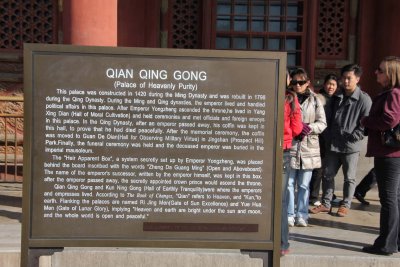
Sign for the Palace of Heavenly Purity was the sleeping quarters of the emperors inside Forbidden City. |
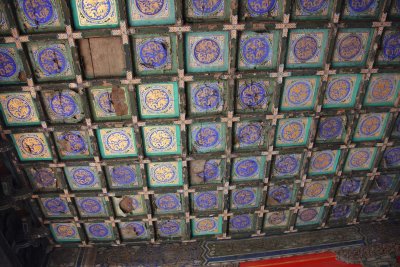
Interesting tile work on the ceiling at the Palace of Heavenly Purity. |
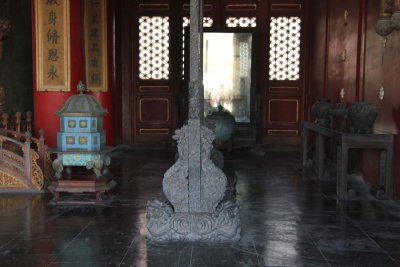
Interior view of the Palace of Heavenly Purity. |

Decorative dragon bas-relief sculpture in the palace. |

Throne inside Palace of Heavenly Purity. |

Palace of Earthly Tranquility (Kunninggong) is the northernmost of the 3 main palaces in the Inner Court of the Forbidden City. |

With a double-eaved roof, giled tiles and side buildings, it looks just like the Palace of Heavenly Purity but smaller. |
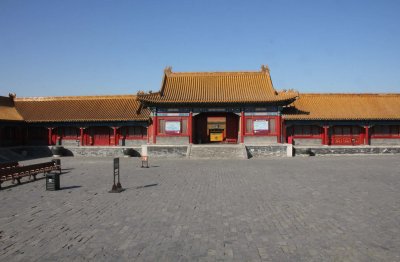
Courtyard and side buildings near the Palace of Earthly Tranquility. |
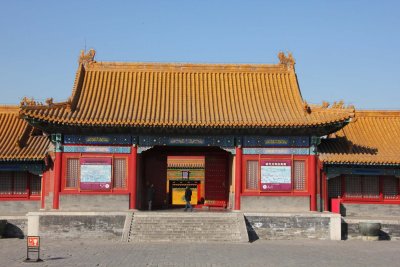
Close-up of one of the side buildings. |
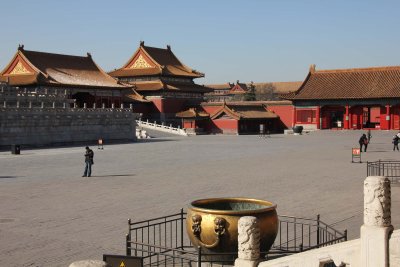
Buildings in the Inner Palace courtyard. |
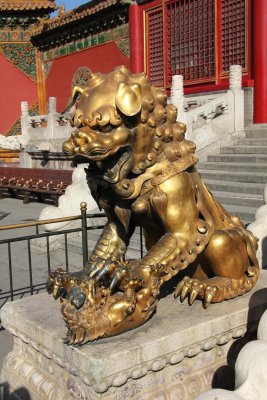
Bronze female lion situated in front of Gate of Heavenly Purity. The lion cub symbolizes fertility of the royal family. |
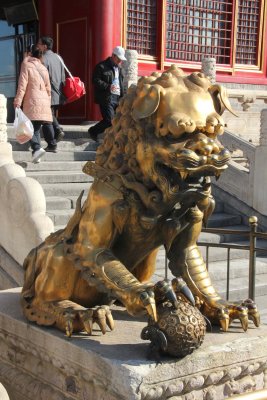
Bronze male lion. Note the bal, which represents the imperial power. |
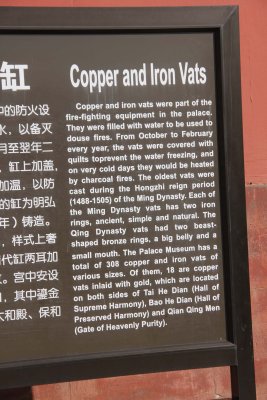
Sign describing how copper and iron vats were filled with water and used for dousing fires in the palace. |
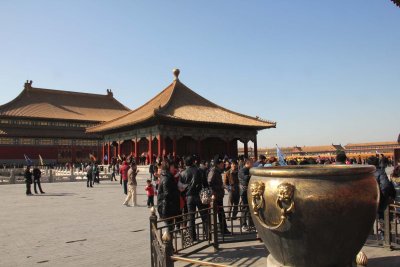
An vat with the Hall of Central Harmony in the background. |
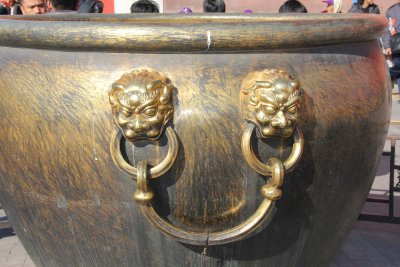
Close-up of one of the vats in the Imperial City. |

Sign for the Hall of Preserved Harmony. It is one of three great halls in Outer Court. |

During the Ming Dynasty, emperors changed their ritual garments in this hall before grand ceremonies. |
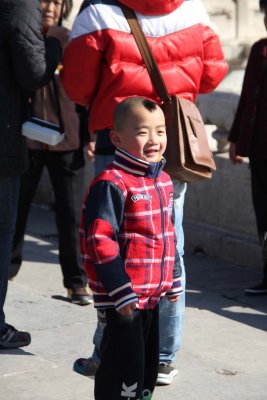
A cute Chinese boy at the Forbidden City. |

Close-up of the Chinese boy. |

Another cute Chinese boy bundled up at the Forbidden City. |
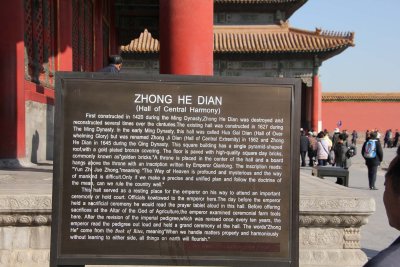
Sign for the Hall of Central Harmony, which served as a resting place for the emperor on his way to important ceremonies. |
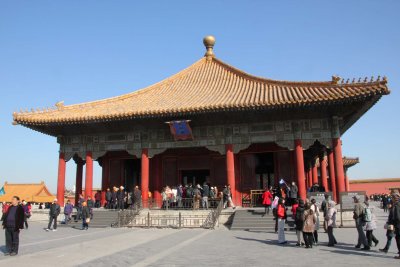
Front view of the Hall of Central Harmony. It was originally built in 1420, restored in 1627 and again 1765. |
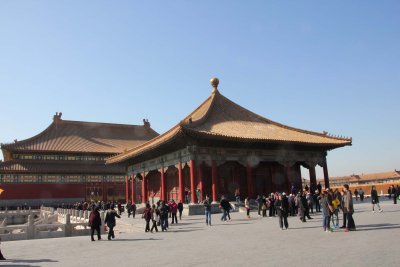
Side view of the Hall of Central Harmony |
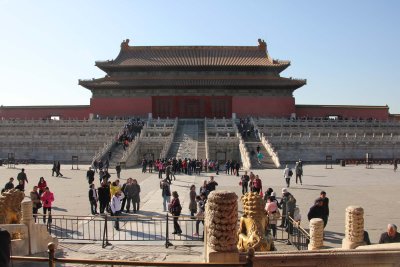
One side of Hall of Supreme Harmony. |
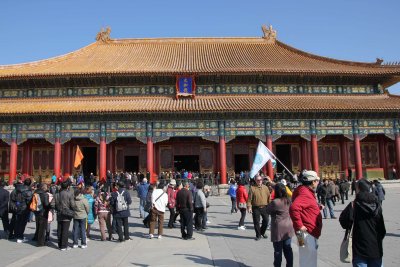
Front view of the Hall of Supreme Harmony. It was the place where emperors received high officials and exercised their rule. |

View inside the Hall of Supreme Harmony. |
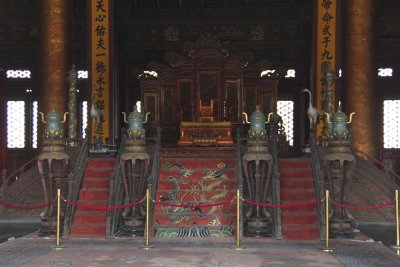
A close-up of the interior. |

Looking down from the Hall of Supreme Harmony. |
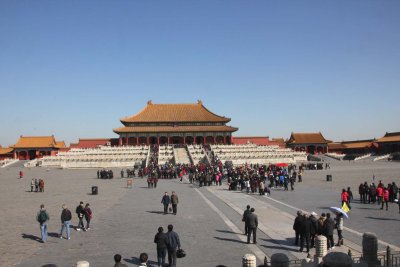
Taihedian Square covers an area of 2,377 square meters. |
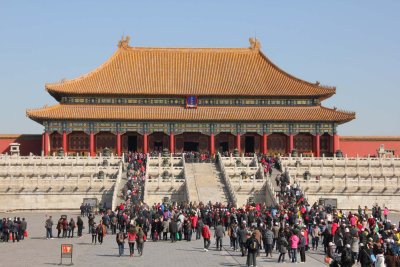
Entering Taihemen Square, you will see Taihedian (Hall of Supreme Harmony). |
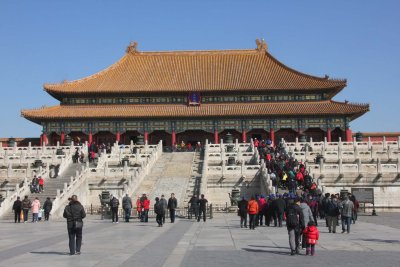
Located in the heart of the Forbidden City, the hall is where where emperors received high officials and exercised their rule. |

Elaborate, labyrinth-like stone walls near the Gate of Preserved Harmony forming the Inner Golden Water River Bridges. |

More stone wall views. |
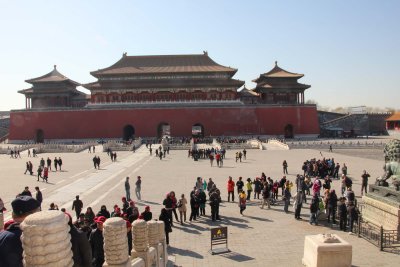
View from the Gate of the Supreme Harmony looking at the Meridian Gate. |
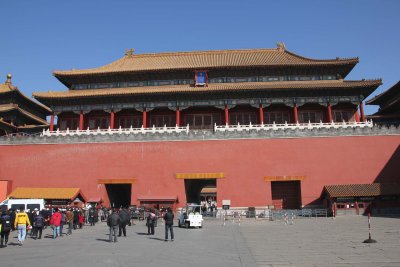
View from inside the Forbidden City looking south at the Meridian Gate. |

View of the Meridian Gate, or Wumen in Chinese. |

It is the southern gate and entrance to the Forbidden City. |

After exiting the Meridian Gate, this pathway leads to Tian'anmen Square. |
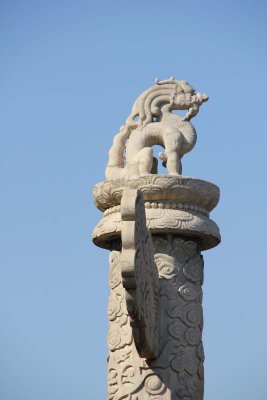
Unusual dragon statue on top of a pillar that I saw walking towards Tian'anmen Square. |
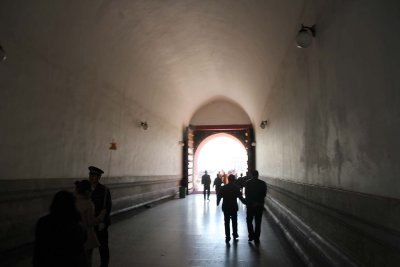
Tunnel that leads to Tian'anmen Square. |











